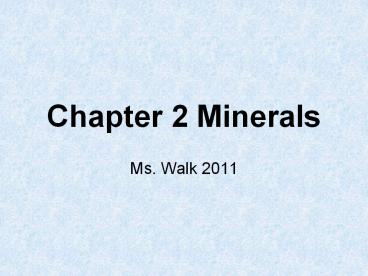Chapter 2 Minerals PowerPoint PPT Presentation
1 / 29
Title: Chapter 2 Minerals
1
Chapter 2 Minerals
- Ms. Walk 2011
2
Bell Work 10/24/11
- Today
- Notes - slides 1-6
- Get a new bell work sheet!!!
- Question What do you know about minerals?
3
(No Transcript)
4
Minerals
- A mineral is an inorganic (not formed from living
things), solid material found in nature that has
a definite crystal structure. There are 4000
different minerals, most of which are made up
from a combination of only 8 elements. - Rocks are usually made up of two or more minerals.
5
Dietary Minerals
- any of a group of inorganic elements that are
essential to humans and animals for normal body
function. - Dietary minerals are derived from the earth's
crust. Plants extract the minerals from the soil,
and humans and animals, in their turn, consume
the plants. - Calcium, Phosphorus, Magnesium, Sodium,
Chlorine, Potassium, Sulfur, Iron, Cobalt,
Chromium, Copper, Fluorine. - http//nutrition.about.com/library/bl_minerals_qui
z.htm
6
Mineral Formation
- Minerals form in many different ways.
- - melted rock inside the earth (magma).
- - melted rock that reaches the earths surface
(lava). - -evaporation of water leaving minerals behind.
(ocean water, salt in cup after ocean water
evaporates) - - precipitation of minerals suspended in water.
(manganese nodules in ocean)
7
Properties of Minerals
- Physical properties are identifiable items such
as color, size, and texture things that can be
observed or measured without changing or
attempting to change the material. - Crystals are solid minerals that have an orderly
pattern of atoms. Crystal size and shape are very
important identifying physical properties.
8
(No Transcript)
9
(No Transcript)
10
- Cleavage and fracture is another clue to a
minerals identity. In the way the mineral breaks
defines what type of mineral it might be. - Cleavage - split into pieces with smooth,
regular planes that reflect light.
11
(No Transcript)
12
(No Transcript)
13
(No Transcript)
14
Fracture mineral that breaks into pieces with
jagged or rough edges
15
- Color offers a valuable way to identify
mineral. Color can also be confusing, for example
fools gold (pyrite) has the same color as real
gold. - Streak and luster Streak is when a sample is
scraped across an unglazed, white tile, called a
streak plate. Based on the color of the streak
left on the plate you can better identify the
mineral. - Luster is how shiny, dull, or pearly a mineral
is, based on how it reflects light.
16
(No Transcript)
17
- Hardness minerals can be separated by how hard
they are. This is done by doing a scratch test
using the Mohs scale of hardness.
18
- Density The amount of matter in a given space.
Mass per unit of space.(heft) is how heavy a rock
is compared to an equal amount of water. - Common MO Minerals
- Galena (lead) Copper
- Fire Clay Barite
- Lime Zinc
- Cement Iron Oxide
19
(No Transcript)
20
(No Transcript)
21
- Gemstones are minerals that are rare and can be
cut and polished, giving them a beautiful
appearance. - Ores minerals that can be sold for a profit.
22
- Rock cycle the continuous changing of rocks
from one kind to another over a long period of
time
23
(No Transcript)
24
- Rocks
- Igneous Rock form when melted rock from inside
Earth cools. - a) Extrusive igneous melted rock cools on
the Earths surface. Small crystal sizes - Ex. Basalt
- b) Intrusive Igneous - Melted rock that cools
below Earths surface. Larger crystal sizes - Ex. Granite
25
- Classifying igneous rocks
- Crystal size
- - fine grained crystals
- - coarse grained crystals
- - porphyritic (large and small crystals)
- 2. Mineral composition
- - light colored
- - dark colored
26
Metamorphic Rocks New rocks that form when
existing rocks are heated or squeezed.
(Metamorphic means to change form)Granite to
gneisstwo types Foliated gneiss Nonfoliated
marble
27
- Sedimentary Rocks Pieces of broken rock,
shells, mineral grains, and other materials that
collects in layers to form rock.
28
- Detrital sedimentary rock fragments of
weathered rocks compacted and cemented together.
Conglomerate, sandstone, siltstone, and shale are
forms of detrital rock. From coarse pebbles to
fine clays. Classified based on sediment size
that forms the rock. - Chemical sedimentary rocks formed when
dissolved mineral come out of solution. Calcium
carbonate is carried in solution in ocean water
When calcium carbonate comes out of solution as
calcite and many crystals grow together forms
limestone.
29
- Organic sedimentary rocks rocks made of the
remains of once-living things. Chalk is an
organic rock made of microscopic shells. Fossils
are the major makeup organic rock.

